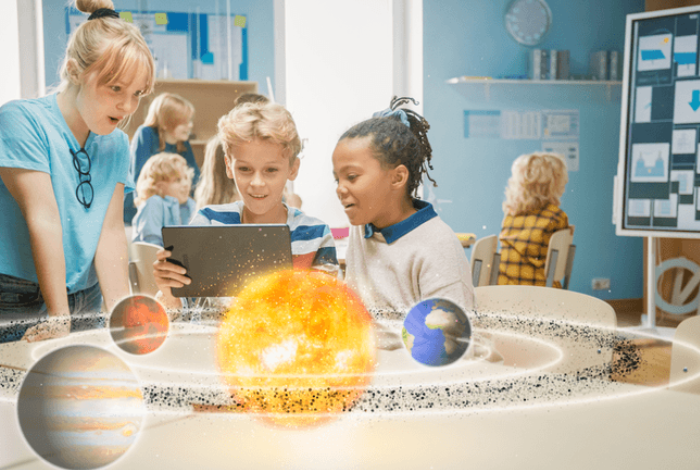Augmented Reality in Education: Enhancing Learning and Engagement

Augmented Reality (AR) is a technology that has been around for decades but has recently been gaining more attention due to its potential applications in the field of education. AR combines virtual reality with real-world elements, allowing for an immersive learning experience. From interactive 3D models to virtual classrooms, the possibilities are endless. In this blog, we will discuss the benefits, challenges, and examples of using augmented reality in education.
What is Augmented Reality?
Augmented Reality (AR) is a technology that overlays digital elements onto the physical world. It is a combination of real-world and virtual-world elements, allowing for an immersive learning experience. AR can be used in many different ways, from displaying 3D models to creating virtual classrooms. AR also has potential applications in teaching and learning. It can provide interactive visualizations of complex concepts, making them easier to understand.
Augmented Reality (AR) is a technology that combines a user’s physical environment with virtual content, allowing them to interact with the digital world in a real-world context. It is a form of interactive multimedia technology, which uses computer-generated 3D images, audio, and other elements to enhance a user’s perception of reality.
Benefits of Using Augmented Reality in Education
Using augmented reality in education can provide numerous benefits. It can make learning more engaging, as students can interact with virtual elements in real time. It also has the potential to increase student motivation and engagement. AR can also provide a more immersive learning experience, as students can explore virtual environments. Finally, AR can provide a more efficient way to learn, as it can facilitate quick access to information and resources.
The concept of AR has been around since the late 1960s but its application in the modern day has been mainly in the entertainment industry. AR technology has been used to create highly immersive virtual worlds in gaming, videos, and virtual reality. More recently, however, its application has been extended to a variety of other industries such as healthcare, education, retail, and manufacturing.
In healthcare, AR can be used to provide physicians with more accurate information about a patient’s condition. For instance, doctors can use AR to monitor a patient’s vital signs, diagnose diseases, and even perform surgery. In education, AR can be used to create interactive learning experiences for students. This technology can be used to create virtual classrooms, provide interactive learning tools, and even engage students with virtual field trips.
The use of AR in education has many benefits, including the ability to bring abstract concepts to life. For example, AR can be used to visualize complex mathematical equations and scientific processes in a more engaging way, which can make these concepts more accessible and easier to understand. AR can also be used to bring historical events and stories to life. By placing virtual elements in real-world settings, students can be transported back in time and gain a better understanding of what life was like during that period.
Challenges and Drawbacks of Augmented Reality in Education
Although augmented reality has many potential benefits, there are also some challenges and drawbacks to consider. One of the main issues is the cost of developing and deploying AR-based learning solutions. Additionally, there is a lack of AR-based content available, and creating content can be time-consuming and expensive. Furthermore, AR-based learning solutions may require additional hardware, such as headsets or motion controllers, which can be costly.
Examples of Augmented Reality in Education
Augmented reality can be used in a variety of ways in educational settings. For example, students can use AR to explore 3D models of complex concepts, such as molecular structures. AR can also be used to create virtual classrooms, allowing students to interact with each other in a virtual environment. AR can also be used to create interactive maps and visualizations, making it easier to comprehend geographical concepts. Finally, AR can be used to create interactive learning games, making learning more fun and engaging.
Conclusion
Augmented reality is a powerful technology with potential applications in the field of education. It can provide an immersive learning experience, making learning more engaging and efficient. However, there are also some challenges and drawbacks to consider, such as the cost of developing and deploying AR-based learning solutions. Nevertheless, the potential benefits of using augmented reality in education are numerous, and it is an exciting technology to explore.




